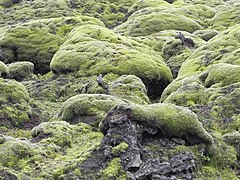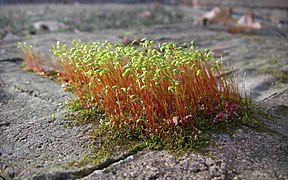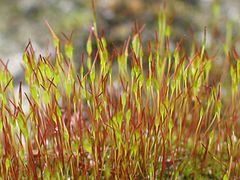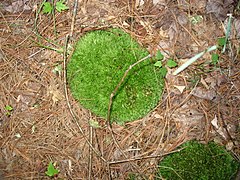Moss
| Moss | |
|---|---|
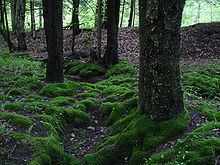
| |
| Clumps of moss on the ground and base of trees in theAllegheny National Forest,Pennsylvania, United States | |
| Scientific classification | |
| Kingdom: | Plantae |
| Clade: | Embryophytes |
| Clade: | Setaphyta |
| Division: | Bryophyta Schimp.sensu stricto |
| Classes[2] | |
| Synonyms | |
| |
Mossesare small,non-vascularflowerlessplantsin the taxonomicdivisionBryophyta(/braɪˈɒfətə/,[3]/ˌbraɪ.əˈfaɪtə/)sensu stricto.Bryophyta (sensu lato,Schimp.1879[4]) may also refer to the parent groupbryophytes,which compriseliverworts,mosses, andhornworts.[5]Mosses typically form dense green clumps or mats, often in damp or shady locations. The individual plants are usually composed of simpleleavesthat are generally only one cell thick, attached to astemthat may be branched or unbranched and has only a limited role in conducting water and nutrients. Although some species have conducting tissues, these are generally poorly developed and structurally different from similar tissue found invascular plants.[6]Mosses do not haveseedsand after fertilisation developsporophyteswith unbranched stalks topped with single capsules containingspores.They are typically 0.2–10 cm (0.1–3.9 in) tall, though some species are much larger.Dawsonia,the tallest moss in the world, can grow to 50 cm (20 in) in height. There are approximately 12,000 species.[2]
Mosses are commonly confused with liverworts, hornworts andlichens.[7]Although often described asnon-vascular plants,many mosses have advanced vascular systems.[8][9]Like liverworts and hornworts, thehaploidgametophytegeneration of mosses is the dominant phase of thelife cycle.This contrasts with the pattern in all vascular plants (seed plantsandpteridophytes), where thediploidsporophyte generation is dominant. Lichens may superficially resemble mosses, and sometimes have common names that include the word "moss" (e.g., "reindeer moss"or"Iceland moss"), but they are fungal symbioses and not related to mosses.[7]: 3
The main commercial significance of mosses is as the main constituent ofpeat(mostly the genusSphagnum), although they are also used for decorative purposes, such as in gardens and in thefloristtrade. Traditional uses of mosses included as insulation and for the ability to absorb liquids up to 20 times their weight. Moss is akeystone genusand benefitshabitat restorationandreforestation.[10]
Physical characteristics
[edit]Description
[edit]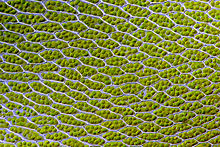
Botanically, mosses arenon-vascular plantsin the land plant division Bryophyta. They are usually small (a few centimeters tall)herbaceous(non-woody) plants that absorb water and nutrients mainly through their leaves and harvestcarbon dioxideand sunlight to create food byphotosynthesis.[11][12]With the exception of the ancient groupTakakiopsida,no known mosses formmycorrhiza,[13]but bryophilous fungi is widespread in moss and other bryophytes, where they live as saprotrophs, parasites, pathogens and mutualists, some of themendophytes.[14]Mosses differ fromvascular plantsin lacking water-bearingxylemtracheidsorvessels.As inliverwortsandhornworts,thehaploidgametophytegeneration is the dominant phase of thelife cycle.This contrasts with the pattern in all vascular plants (seed plantsandpteridophytes), where thediploidsporophytegeneration is dominant. Mosses reproduce usingspores,notseeds,and have no flowers.

Moss gametophytes have stems which may be simple or branched and upright (acrocarp) or prostrate (pleurocarp). The early divergent classes Takakiopsida, Sphagnopsida, Andreaeopsida and Andreaeobryopsida either lackstomataor have pseudostomata that do not form pores. In the remaining classes, stomata have been lost more than 60 times.[15]Their leaves are simple, usually only a single layer of cells with no internal air spaces, often with thicker midribs (nerves). The nerve can run beyond the edge of the leaf tip, termed excurrent. The tip of the leaf blade can be extended as a hair point, made of colourless cells. These appear white against the dark green of the leaves. The edge of the leaf can be smooth or it may have teeth. There may be a distinct type of cell defining the edge of the leaf, distinct in shape and/or colour from the other leaf cells.[16]
Moss has threadlikerhizoidsthat anchor them to their substrate, comparable toroot hairsrather than the more substantialrootstructures ofspermatophytes.[17]Mosses do not absorb water or nutrients from their substrate through their rhizoids.[citation needed]They can be distinguished fromliverworts(Marchantiophytaor Hepaticae) by their multi-cellular rhizoids. Spore-bearing capsules orsporangiaof mosses are borne singly on long, unbranched stems, thereby distinguishing them from thepolysporangiophytes,which include all vascular plants. The spore-producing sporophytes (i.e. thediploidmulticellular generation) are short-lived and usually capable of photosynthesis, but are dependent on the gametophyte for water supply and most or all of its nutrients.[18]Also, in the majority of mosses, the spore-bearing capsule enlarges and matures after its stalk elongates, while in liverworts the capsule enlarges and matures before its stalk elongates.[12]Other differences are not universal for all mosses and all liverworts, but the presence of a clearly differentiated stem with simple-shaped, non-vascular leaves that are not arranged in three ranks, all point to the plant being a moss.[citation needed]
Life cycle
[edit]Vascularplantshave two sets ofchromosomesin their vegetative cells and are said to bediploid,i.e. each chromosome has a partner that contains the same, or similar, genetic information. By contrast, mosses and otherbryophyteshave only a single set of chromosomes and so arehaploid(i.e. each chromosome exists in a unique copy within the cell). There is a period in the moss life cycle when they do have a double set of paired chromosomes, but this happens only during thesporophytestage.
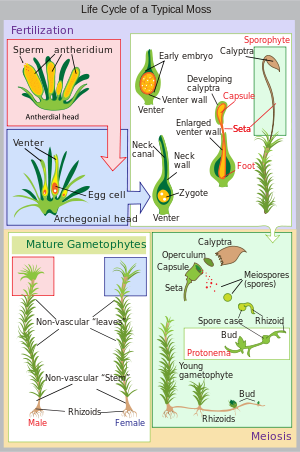
The moss life-cycle starts with a haploidsporethat germinates to produce aprotonema(pl.protonemata), which is either a mass of thread-like filaments or thalloid (flat and thallus-like). Massed moss protonemata typically look like a thin green felt, and may grow on damp soil, tree bark, rocks, concrete, or almost any other reasonably stable surface. This is a transitory stage in the life of a moss, but from the protonema grows thegametophore( "gamete-bearer" ) that is structurally differentiated into stems and leaves. A single mat of protonemata may develop several gametophore shoots, resulting in a clump of moss.
From the tips of the gametophore stems or branches develop the sex organs of the mosses. The female organs are known asarchegonia(sing.archegonium) and are protected by a group of modified leaves known as the perichaetum (plural, perichaeta). The archegonia are small flask-shaped clumps of cells with an open neck (venter) down which the male sperm swim. The male organs are known asantheridia(sing.antheridium) and are enclosed by modified leaves called the perigonium (pl.perigonia). The surrounding leaves in some mosses form a splash cup, allowing the sperm contained in the cup to be splashed to neighboring stalks by falling water droplets.[19]
Gametophore tip growth is disrupted by fungalchitin.[20][21][22]Galottoet al.,2020 appliedchitooctaoseand found that tips detected and responded to this chitin derivative by changinggene expression.[20][21][22]They concluded that this defense response was probablyconservedfrom themost recent common ancestorofbryophytesandtracheophytes.[20]Orret al.,2020 found that themicrotubulesof growing tip cells were structurally similar toF-actinand served a similar purpose.[21]
Mosses can be eitherdioicous(comparedioeciousin seed plants) ormonoicous(comparemonoecious). In dioicous mosses, male and female sex organs are borne on different gametophyte plants. In monoicous (also called autoicous) mosses, both are borne on the same plant. In the presence of water, sperm from the antheridia swim to the archegonia andfertilisationoccurs, leading to the production of a diploid sporophyte. The sperm of mosses is biflagellate, i.e. they have two flagellae that aid in propulsion. Since the sperm must swim to the archegonium, fertilisation cannot occur without water. Some species (for exampleMnium hornumor several species ofPolytrichum) keep their antheridia in so called 'splash cups', bowl-like structures on the shoot tips that propel the sperm several decimeters when water droplets hit it, increasing the fertilization distance.[19]
After fertilisation, the immature sporophyte pushes its way out of the archegonial venter. It takes several months for thesporophyteto mature. The sporophyte body comprises a long stalk, called a seta, and a capsule capped by a cap called theoperculum.The capsule and operculum are in turn sheathed by a haploid calyptra which is the remains of the archegonial venter. The calyptra usually falls off when the capsule is mature. Within the capsule, spore-producing cells undergomeiosisto form haploid spores, upon which the cycle can start again. The mouth of the capsule is usually ringed by a set of teeth called peristome. This may be absent in some mosses.[citation needed]
Most mosses rely on the wind to disperse the spores. In thegenusSphagnumthespores are projectedabout 10–20 cm (4–8 in) off the ground by compressed air contained in the capsules; the spores are accelerated to about 36,000 times theearth's gravitational accelerationg.[23][24]

It has recently been found that microarthropods, such asspringtailsandmites,can effect moss fertilization[25]and that this process is mediated by moss-emitted scents. Male and femalefire moss,for example emit different and complex volatile organic scents.[26]Female plants emit more compounds than male plants.Springtailswere found to choose female plants preferentially, and one study found that springtails enhance moss fertilization, suggesting a scent-mediated relationship analogous to the plant-pollinator relationship found in many seed plants.[26]The stinkmoss speciesSplachnum sphaericumdevelops insect pollination further by attracting flies to its sporangia with a strong smell of carrion, and providing a strong visual cue in the form of red-coloured swollen collars beneath each spore capsule. Flies attracted to the moss carry its spores to fresh herbivore dung, which is the favoured habitat of the species of this genus.[27]
In many mosses, e.g.,Ulota phyllantha,green vegetative structures calledgemmaeare produced on leaves or branches, which can break off and form new plants without the need to go through the cycle of fertilization. This is a means ofasexual reproduction,and the genetically identical units can lead to the formation ofclonalpopulations.
Dwarf males
[edit]Moss dwarf males (also known asnannandryorphyllodioicy) originate from wind-dispersed malesporesthat settle and germinate on the female shoot where their growth is restricted to a few millimeters. In some species, dwarfness is genetically determined, in that all male spores become dwarf.[28]More often, it is environmentally determined in that male spores that land on a female become dwarf, while those that land elsewhere develop into large, female-sized males.[28][29][30][31]In the latter case, dwarf males that are transplanted from females to another substrate develop into large shoots, suggesting that the females emit a substance which inhibits the growth of germinating males and possibly also quickens their onset of sexual maturation.[30][31]The nature of such a substance is unknown, but the phytohormoneauxinmay be involved[28]
Having the males growing as dwarfs on the female is expected to increase thefertilizationefficiency by minimizing the distance between male and female reproductive organs. Accordingly, it has been observed that fertilization frequency is positively associated with the presence of dwarf males in severalphyllodioicousspecies.[32][33]
Dwarf males occur in several unrelatedlineages[33][34]and may be more common than previously thought.[33]For example, it is estimated that between one quarter and half of alldioicouspleurocarpshave dwarf males.[33]
DNA repair
[edit]The mossPhyscomitrium patenshas been used as amodel organismto study how plantsrepairdamage to their DNA, especially the repair mechanism known ashomologous recombination.If the plant cannot repair DNA damage, e.g.,double-strand breaks,in theirsomatic cells,the cells can lose normal functions or die. If this occurs duringmeiosis(part of sexual reproduction), they could become infertile. The genome ofP. patenshas been sequenced, which has allowed several genes involved in DNA repair to be identified.[35]P. patensmutants that are defective in key steps of homologous recombination have been used to work out how the repair mechanism functions in plants. For example, a study ofP. patensmutants defective inRpRAD51, a gene that encodes a protein at the core of the recombinational repair reaction, indicated that homologous recombination is essential for repairing DNA double-strand breaks in this plant.[36]Similarly, studies of mutants defective inPpmre11orPprad50(that encode key proteins of theMRN complex,the principal sensor of DNA double-strand breaks) showed that these genes are necessary for repair of DNA damage as well as for normal growth and development.[37]
Classification
[edit]More recently, mosses have been grouped with theliverwortsandhornwortsin the divisionBryophyta(bryophytes,or Bryophytasensu lato).[5][38][39][40][41][42][43][44][45][excessive citations]The bryophyte division itself contains three (former) divisions: Bryophyta (mosses),Marchantiophyta(liverworts) andAnthocerotophyta(hornworts); it has been proposed that these latter divisions are de-ranked to the classes Bryopsida, Marchantiopsida, and Anthocerotopsida, respectively.[5]The mosses and liverworts are now considered to belong to a clade calledSetaphyta.[39][46][47]
The mosses, (Bryophyta sensu stricto), are divided into eight classes:
divisionBryophyta
|
| |||||||||||||||||||||||||||||||||||||||||||||||||||
| The currentphylogenyand composition of the Bryophyta.[2][48] | ||||||||||||||||||||||||||||||||||||||||||||||||||||

Six of the eight classes contain only one or two genera each. Polytrichopsida includes 23 genera, and Bryopsida includes the majority of moss diversity with over 95% of moss species belonging to this class.
The Sphagnopsida, the peat-mosses, comprise the two living generaAmbuchananiaandSphagnum,as well as fossil taxa.Sphagnumis a diverse, widespread, and economically important one. These large mosses form extensive acidic bogs in peat swamps. The leaves ofSphagnumhave large dead cells alternating with living photosynthetic cells. The dead cells help to store water. Aside from this character, the unique branching, thallose (flat and expanded) protonema, and explosively rupturing sporangium place it apart from other mosses.
Andreaeopsida and Andreaeobryopsida are distinguished by the biseriate (two rows of cells) rhizoids, multiseriate (many rows of cells) protonema, and sporangium that splits along longitudinal lines. Most mosses have capsules that open at the top.
Polytrichopsida have leaves with sets of parallel lamellae, flaps of chloroplast-containing cells that look like the fins on a heat sink. These carry out photosynthesis and may help to conserve moisture by partially enclosing the gas exchange surfaces. The Polytrichopsida differ from other mosses in other details of their development and anatomy too, and can also become larger than most other mosses, with e.g.,Polytrichum communeforming cushions up to 40 cm (16 in) high. The tallest land moss, a member of the Polytrichidae is probablyDawsonia superba,a native toNew Zealandand other parts ofAustralasia.
Geological history
[edit]
The fossil record of moss is sparse, due to their soft-walled and fragile nature. Unambiguous moss fossils have been recovered from as early as thePermianof Antarctica and Russia, and a case has been made forCarboniferousmosses.[49]It has further been claimed that tube-like fossils from theSilurianare the macerated remains of mosscalyptræ.[50]Mosses also appear to evolve 2–3 times slower than ferns,gymnospermsandangiosperms.[51]
Recent research shows that ancient moss could explain why theOrdovicianice ages occurred. When the ancestors of today's moss started to spread on land 470 million years ago, they absorbed CO2from the atmosphere and extracted minerals by secreting organic acids that dissolved the rocks they were growing on. These chemically altered rocks in turn reacted with the atmospheric CO2and formed new carbonate rocks in the ocean through the weathering of calcium and magnesium ions from silicate rocks. The weathered rocks also released significant amounts of phosphorus and iron which ended up in the oceans, where it caused massive algal blooms, resulting in organic carbon burial, extracting more carbon dioxide from the atmosphere. Small organisms feeding on the nutrients created large areas without oxygen, which caused a mass extinction of marine species, while the levels of CO2dropped all over the world, allowing the formation of ice caps on the poles.[52][53]
Ecology
[edit]Habitat
[edit]-
Dense moss colonies in a cool coastal forest
-
A cool high altitude/latitude moss forest; the forest floor is covered in moss, beneath conifers
-
Moss growing along the stream from akarst spring;travertinedeposits from the stream water and the moss overgrows it, forming this ridge, with the stream on top.
-
Moss with sporophytes on brick
-
Youngsporophytesof the common mossTortula muralis(wall screw-moss)
-
Retaining wallcovered in moss
-
A small clump of moss beneath a conifer (a shady, usually dry place)
-
Moss on a concrete wall
-
Moss (Bryophyta) on the forest floor in Broken Bow, Oklahoma
Mossgametophytesareautotrophicand requiresunlightto performphotosynthesis.[54]Shadetolerance varies by species, just as it does with higher plants. In most areas, mosses grow chiefly in moist, shaded areas, such as wooded areas and at the edges of streams, but they can grow anywhere in cool, humid, cloudy climates, and some species are adapted to sunny, seasonally dry areas like alpine rocks or stabilized sand dunes.
Choice of substrate varies by species as well. Moss species can be classed as growing on: rocks, exposed mineral soil, disturbed soils, acid soil, calcareous soil, cliff seeps and waterfall spray areas, streamsides, shadedhumusysoil, downed logs, burnt stumps, tree trunk bases, upper tree trunks, and tree branches or inbogs.Moss species growing on or under trees are often specific about the species of trees they grow on, such as preferringconifersoverbroadleaf trees,oaksoveralders,or vice versa.[12]While mosses often grow on trees asepiphytes,they are never parasitic on the tree.
Mosses are also found in cracks between paving stones in damp city streets, and on roofs. Some species adapted to disturbed, sunny areas are well adapted to urban conditions and are commonly found in cities. Examples would beRhytidiadelphus squarrosus,a garden weed in Vancouver and Seattle areas;Bryum argenteum,the cosmopolitan sidewalk moss, andCeratodon purpureus,red roof moss, another cosmopolitan species. A few species are wholly aquatic, such asFontinalis antipyretica,common water moss; and others such asSphagnuminhabit bogs, marshes and very slow-moving waterways.[12]Such aquatic or semi-aquatic mosses can greatly exceed the normal range of lengths seen in terrestrial mosses. Individual plants 20–30 cm (8–12 in) or more long are common inSphagnumspecies for example. But even aquatic species of moss and other bryophytes needs their mature capsules to be exposed to air by seta elongation or seasonal lowering of water level to be able to reproduce.[55]
Wherever they occur, mosses require liquid water for at least part of the year to complete fertilisation. Many mosses can survivedesiccation,sometimes for months, returning to life within a few hours of rehydration.[54]
It is generally believed that in theNorthern Hemisphere,the north side of trees and rocks will generally have more luxuriant moss growth on average than other sides.[56]The reason is assumed to be becausesunshineon the south side causes a dry environment. The reverse would be true in theSouthern Hemisphere.Some naturalists feel that mosses grow on the damper side of trees and rocks.[11]In some cases, such as sunny climates intemperatenorthern latitudes, this will be the shaded north side of the tree or rock. On steep slopes, it may be the uphill side. For mosses that grow on tree branches, this is generally the upper side of the branch on horizontally growing sections or near the crotch. In cool, humid, cloudy climates, all sides of tree trunks and rocks may be equally moist enough for moss growth. Each species of moss requires certain amounts of moisture and sunlight and thus will grow on certain sections of the same tree or rock.
Some mosses grow underwater, or completely waterlogged. Many prefer well-drained locations. There are mosses that preferentially grow on rocks and tree trunks of various chemistries.[57]
Relationship with cyanobacteria
[edit]Inboreal forests,some species of moss play an important role in providing nitrogen for the ecosystem due to their relationship withnitrogen-fixingcyanobacteria.Cyanobacteria colonize moss and receive shelter in return for providing fixed nitrogen. Moss releases the fixed nitrogen, along with other nutrients, into the soil "upon disturbances like drying-rewetting and fire events", making it available throughout the ecosystem.[58]
Cultivation
[edit]

Moss is often considered aweedin grass lawns, but is deliberately encouraged to grow under aesthetic principles exemplified byJapanese gardening.In old temple gardens, moss can carpet a forest scene. Moss is thought to add a sense of calm, age, and stillness to a garden scene. Moss is also used inbonsaito cover the soil and enhance the impression of age.[59]Rules of cultivation are not widely established. Moss collections are quite often begun using samples transplanted from the wild in a water-retaining bag. Some species of moss can be extremely difficult to maintain away from their natural sites with their unique requirements of combinations of light, humidity, substrate chemistry, shelter from wind, etc.
Growing moss from spores is even less controlled. Moss spores fall in a constant rain on exposed surfaces; those surfaces which are hospitable to a certain species of moss will typically be colonised by that moss within a few years of exposure to wind and rain. Materials which are porous and moisture retentive, such asbrick,wood,and certain coarse concrete mixtures, are hospitable to moss. Surfaces can also be prepared with acidic substances, includingbuttermilk,yogurt,urine,and gently puréed mixtures of moss samples, water andericaceous compost.
In the cool, humid, cloudyPacific Northwest,moss is sometimes allowed to grow naturally as amoss lawn,one that needs little or no mowing, fertilizing or watering. In this case, grass is considered to be the weed.[60]Landscapers in the Seattle area sometimes collect boulders and downed logs growing mosses for installation in gardens and landscapes. Woodland gardens in many parts of the world can include a carpet of natural mosses.[54]TheBloedel Reserveon Bainbridge Island, Washington State, is famous for its moss garden. The moss garden was created by removing shrubby underbrush and herbaceous groundcovers, thinning trees, and allowing mosses to fill in naturally.[61]
Green roofs and walls
[edit]
Mosses are sometimes used ingreen roofs.Advantages of mosses over higher plants in green roofs include reduced weight loads, increased water absorption, no fertilizer requirements, and high drought tolerance. Since mosses do not have true roots, they require less planting medium than higher plants with extensive root systems. With proper species selection for the local climate, mosses in green roofs require no irrigation once established and are low maintenance.[62]Mosses are also used ongreen walls.
Mossery
[edit]A passing fad for moss-collecting in the late 19th century led to the establishment of mosseries in many British and American gardens. The mossery is typically constructed out of slatted wood, with a flat roof, open to the north side (maintaining shade). Samples of moss were installed in the cracks between wood slats. The whole mossery would then be regularly moistened to maintain growth.
Aquascaping
[edit]Aquascapinguses many aquatic mosses. They do best at low nutrient, light, and heat levels, and propagate fairly readily. They help maintain a water chemistry suitable for aquarium fish.[63]They grow more slowly than many aquarium plants, and are fairly hardy.[64]
Growth inhibition
[edit]Moss can be a troublesome weed in containerized nursery operations and greenhouses.[65]Vigorous moss growth can inhibit seedling emergence and penetration of water and fertilizer to the plant roots.
Moss growth can be inhibited by a number of methods:
- Decreasing availability ofwaterthroughdrainage.
- Increasing direct sunlight.
- Increasing number and resources available for competitive plants likegrasses.
- Increasing thesoil pHwith the application oflime.
- Heavy traffic or manually disturbing the moss bed with a rake
- Application of chemicals such asferrous sulfate(e.g., in lawns) or bleach (e.g., on solid surfaces).
- In containerized nursery operations, coarse mineral materials such as sand, gravel, and rock chips are used as a fast-draining top dressing in plant containers to discourage moss growth.
The application of products containing ferrous sulfate orferrous ammonium sulfatewill kill moss; these ingredients are typically in commercial moss control products andfertilizers.Sulfurandironareessential nutrientsfor some competing plants like grasses. Killing moss will not prevent regrowth unless conditions favorable to their growth are changed.[66]
Uses
[edit]
Traditional
[edit]Preindustrial societies made use of the mosses growing in their areas.
Sámipeople,North American tribes,and othercircumpolar peoplesused mosses for bedding.[11][54]Mosses have also been used as insulation both for dwellings and in clothing. Traditionally, dried moss was used in some Nordic countries and Russia as an insulator between logs inlog cabins,and tribes of the northeastern United States and southeastern Canada used moss to fill chinks in wooden longhouses.[54]Circumpolar and alpine peoples have used mosses for insulation in boots and mittens.Ötzi the Icemanhad moss-packed boots.[54]
The capacity of dried mosses to absorb fluids has made their use practical in both medical and culinary uses. North American tribal people used mosses for diapers, wound dressing, and menstrual fluid absorption.[54]Tribes of the Pacific Northwest in the United States and Canada used mosses to clean salmon prior to drying it, and packed wet moss into pit ovens for steamingcamasbulbs. Food storage baskets and boiling baskets were also packed with mosses.[54]
Recent research investigating the Neanderthals remains recovered from El Sidrón have provided evidence that their diet would have consisted primarily of pine nuts, moss and mushrooms. This is contrasted by evidence from other European locations, which point to a more carnivorous diet.[67]
InFinland,peat mosses have been used to make bread duringfamines.[68]
Commercial
[edit]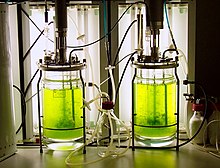
There is a substantial market in mosses gathered from the wild. The uses for intact moss are principally in thefloristtrade and for home decoration. Decaying moss in the genusSphagnumis also the major component ofpeat,which is "mined" for use as afuel,as ahorticulturalsoil additive, and in smokingmaltin the production ofScotch whisky.
Sphagnummoss, generally the speciesS. cristatumandS. subnitens,is harvested while still growing and is dried out to be used in nurseries and horticulture as a plant growing medium.
SomeSphagnummosses can absorb up to 20 times their own weight in water.[69]InWorld War I,Sphagnummosses were used as first-aid dressings on soldiers' wounds, as these mosses said to absorb liquids three times faster than cotton, retain liquids better, better distribute liquids uniformly throughout themselves, and are cooler, softer, and be less irritating.[69]It is also claimed to have antibacterial properties.[70]Native Americanswere one of the peoples to useSphagnumfor diapers andmenstrual pads,which is still done inCanada.[71]
In ruralUK,Fontinalis antipyreticawas traditionally used to extinguish fires as it could be found in substantial quantities in slow-moving rivers and the moss retained large volumes of water which helped extinguish the flames. This historical use is reflected in itsspecificLatin/Greekname, which means "against fire".
InMexico,moss is used as aChristmasdecoration.
Physcomitrium patensis increasingly used inbiotechnology.Prominent examples are the identification of mossgenes with implications forcropimprovement or humanhealth[72]and the safe production of complexbiopharmaceuticalsin the mossbioreactor,developed byRalf Reskiand his co-workers.[73]
London installed several structures called "City Trees": moss-filled walls, each of which is claimed to have "the air-cleaning capability of 275 regular trees" by consuming nitrogen oxides and other types of air pollution and producing oxygen.[74]
References
[edit]- ^Hubers, M.; Kerp, H. (2012). "Oldest known mosses discovered in Mississippian (late Visean) strata of Germany".Geology.40(8): 755–58.Bibcode:2012Geo....40..755H.doi:10.1130/G33122.1.
- ^abcGoffinet, Bernard; William R. Buck (2004). "Systematics of the Bryophyta (Mosses): From molecules to a revised classification".Monographs in Systematic Botany.Molecular Systematics of Bryophytes. Vol. 98. Missouri Botanical Garden Press. pp. 205–239.ISBN978-1-930723-38-2.
- ^"Bryophyta".Merriam-Webster.com Dictionary.Merriam-Webster.
- ^Schimper, W. P. (1879). "Bryophyta". In Zittel, K.A. (ed.).Handbuch der Palaeontologie.Vol. 2. R. Oldenbourg.
- ^abcde Sousa, Filipe; et al. (2019)."Nuclear protein phylogenies support the monophyly of the three bryophyte groups (Bryophyta Schimp.)".New Phytologist.222(1): 565–75.doi:10.1111/nph.15587.hdl:1983/0b471d7e-ce54-4681-b791-1da305d9e53b.PMID30411803.S2CID53240320.
- ^Ligrone, R.; Duckett, J.G.; Renzaglia, K.S. (2000)."Conducting tissues and phyletic relationships of bryophytes".Philos Trans R Soc Lond B Biol Sci.355(1398): 795–813.doi:10.1098/rstb.2000.0616.PMC1692789.PMID10905610.
- ^abLichens of North America, Irwin M. Brodo, Sylvia Duran Sharnoff,ISBN978-0-300-08249-4,2001
- ^Bell, N. E. & Hyvönen, J. (2010)."Phylogeny of the moss class Polytrichopsida (BRYOPHYTA): Generic-level structure and incongruent gene trees".Molecular Phylogenetics and Evolution.55(2): 381–398.doi:10.1016/j.ympev.2010.02.004.PMID20152915.
- ^Bodribb, T.J.; et al. (2020). "Advanced vascular function discovered in a widespread moss".Nature Plants.6(3): 273–279.doi:10.1038/s41477-020-0602-x.PMID32170283.S2CID212641738.
- ^Rochefort, Line (2000)."Sphagnum: A Keystone Genus in Habitat Restoration".The Bryologist.103(3): 503–508.doi:10.1639/0007-2745(2000)103[0503:SAKGIH]2.0.CO;2.ISSN0007-2745.JSTOR3244138.S2CID55699307.
- ^abcMathews, Daniel (1994).Cascade-Olympic Natural History.Portland, Oregon:Audubon Societyof Portland/Raven Editions.ISBN978-0-9620782-0-0.
- ^abcdPojar and MacKinnon (1994).Plants of the Pacific Northwest Coast.Vancouver, British Columbia: Lone Pine Publishing.ISBN978-1-55105-040-9.
- ^Presence of three mycorrhizal genes in the common ancestor of land plants suggests a key role of mycorrhizas in the colonization of land by plants
- ^Using 454 sequencing for exploring diversity, host specificity and tissue specificity of the fungal genus Galerina associated with four boreal mosses
- ^With Over 60 Independent Losses, Stomata Are Expendable in Mosses
- ^Atherton, Ian; Bosanquet, Sam; Lawley, Mark (2010).Mosses and Liverworts of Britain and Ireland - a field guide.British Bryological Society. p. 848.ISBN9780956131010.
- ^Watson, E. Vernon (1981).British Mosses and Liverworts(3rd ed.). Cambridge University Press. p. 519.ISBN052129472X.
- ^Budke, Jessica M; Bernard, Ernest C; Gray, Dennis J; Huttunen, Sanna; Piechulla, Birgit; Trigiano, Robert N (2018). "Introduction to the special issue on bryophytes".Critical Reviews in Plant Sciences.37(2–3): 102–112.doi:10.1080/07352689.2018.1482396.
- ^abvan der Velde, M.; During, H. J.; van de Zande, L.; Bijlsma, R. (2001). "The reproductive biology of Polytrichum formosum: clonal structure and paternity revealed by microsatellites".Molecular Ecology.10(10): 2423–2434.Bibcode:2001MolEc..10.2423V.doi:10.1046/j.0962-1083.2001.01385.x.PMID11742546.S2CID19716812.
- ^abcDelaux, Pierre-Marc; Schornack, Sebastian (19 February 2021)."Plant evolution driven by interactions with symbiotic and pathogenic microbes"(PDF).Science.371(6531).American Association for the Advancement of Science(AAAS): 1–10.doi:10.1126/science.aba6605.ISSN0036-8075.PMID33602828.S2CID231955632.
- ^abcBibeau, Jeffrey P.; Galotto, Giulia; Wu, Min; Tüzel, Erkan; Vidali, Luis (6 April 2021)."Quantitative cell biology of tip growth in moss".Plant Molecular Biology.107(4–5).Springer:227–244.doi:10.1007/s11103-021-01147-7.ISSN0167-4412.PMC8492783.PMID33825083.
- ^abSun, Guiling; Bai, Shenglong; Guan, Yanlong; Wang, Shuanghua; Wang, Qia; Liu, Yang; Liu, Huan; Goffinet, Bernard; Zhou, Yun; Paoletti, Mathieu; Hu, Xiangyang; Haas, Fabian B.; Fernandez-Pozo, Noe; Czyrt, Alia; Sun, Hang; Rensing, Stefan A.; Huang, Jinling (31 July 2020)."Are fungi-derived genomic regions related to antagonism towards fungi in mosses?".New Phytologist.228(4). New Phytologist Foundation (Wiley): 1169–1175.doi:10.1111/nph.16776.ISSN0028-646X.PMID32578878.S2CID220047618.
- ^Johan L. van Leeuwen (23 July 2010). "Launched at 36,000g".Science.329(5990): 395–6.doi:10.1126/science.1193047.PMID20651138.S2CID206527957.
- ^Dwight K. Whitaker & Joan Edwards (23 July 2010). "SphagnumMoss Disperses Spores with Vortex Rings ".Science.329(5990): 406.Bibcode:2010Sci...329..406W.doi:10.1126/science.1190179.PMID20651145.S2CID206526774.
- ^Cronberg, N.; Natcheva, R.; Hedlund, K. (2006). "Microarthropods Mediate Sperm Transfer in Mosses".Science.313(5791): 1255.doi:10.1126/science.1128707.PMID16946062.S2CID11555211.
- ^abRosenstiel, T. N.; Shortlidge, E. E.; Melnychenko, A. N.; Pankow, J. F.; Eppley, S. M. (2012). "Sex-specific volatile compounds influence microarthropod-mediated fertilization of moss".Nature.489(7416): 431–433.Bibcode:2012Natur.489..431R.doi:10.1038/nature11330.PMID22810584.S2CID4419337.
- ^Vaizey, J. R. (1890). "On the Morphology of the Sporophyte ofSplachnum luteum".Annals of Botany.1:1–8.doi:10.1093/oxfordjournals.aob.a090623.
- ^abcUne, Kouji (1985)."Sexual dimorphism in the Japanese species of Macromitrium Brid.(Musci: Orthotrichaceae)".The Journal of the Hattori Botanical Laboratory Devoted to Bryology and Lichenology.59:487–513.
- ^Blackstock, T. H. (1987). "The male gametophores of Leucobryum glaucum (Hedw.) Ångstr. and L. juniperoideum (Brid.) C. Muell. in two Welsh woodlands".Journal of Bryology.14(3): 535–541.Bibcode:1987JBryo..14..535B.doi:10.1179/jbr.1987.14.3.535.
- ^abLoveland, Hugh Frank (1956).Sexual dimorphism in the moss genus Dicranum Hedw. (Dissertation).University of Michigan.
- ^abWallace, M. H. (1970).Developmental morphology and sexual dimorphism in Homalothecium megaptilum (Sull.) Robins. (Dissertation).Washington State University.
- ^Sagmo Solli, I. M.; Söderström, Lars; Bakken, Solveig; Flatberg, Kjell Ivar; Pedersen, Bård (1998). "Studies of fertility of Dicranum majus in two populations with contrasted sporophyte production".Journal of Bryology.22(1): 3–8.doi:10.1179/jbr.2000.22.1.3.S2CID85349694.
- ^abcdHedenäs, Lars; Bisang, Irene (2011). "The overlooked dwarf males in mosses—unique among green land plants".Perspectives in Plant Ecology, Evolution and Systematics.13(2): 121–135.doi:10.1016/j.ppees.2011.03.001.
- ^Ramsay, Helen P.; Berrie, G. K. (1982). "Sex determination in bryophytes".Journal of the Hattori Botanical Laboratory.52:255–274.
- ^Rensing, S.A.; Lang, D; Zimmer, A.D.; Terry, A.; Salamov, A; Shapiro, H.; Nishiyama, T.; et al. (January 2008)."The Physcomitrella genome reveals evolutionary insights into the conquest of land by plants"(PDF).Science.319(5859): 64–9.Bibcode:2008Sci...319...64R.doi:10.1126/science.1150646.hdl:11858/00-001M-0000-0012-3787-A.PMID18079367.S2CID11115152.
- ^Markmann-Mulisch U, Wendeler E, Zobell O, Schween G, Steinbiss HH, Reiss B (October 2007)."Differential requirements for RAD51 in Physcomitrella patens and Arabidopsis thaliana development and DNA damage repair".Plant Cell.19(10): 3080–9.doi:10.1105/tpc.107.054049.PMC2174717.PMID17921313.
- ^Kamisugi Y, Schaefer DG, Kozak J, Charlot F, Vrielynck N, Holá M, Angelis KJ, Cuming AC, Nogué F (April 2012)."MRE11 and RAD50, but not NBS1, are essential for gene targeting in the moss Physcomitrella patens".Nucleic Acids Res.40(8): 3496–510.doi:10.1093/nar/gkr1272.PMC3333855.PMID22210882.
- ^Cox, Cymon J.; et al. (2014)."Conflicting Phylogenies for Early Land Plants are Caused by Composition Biases among Synonymous Substitutions".Systematic Biology.63(2): 272–279.doi:10.1093/sysbio/syt109.PMC3926305.PMID24399481.
- ^abPuttick, Mark N.; et al. (2018). "The Interrelationships of Land Plants and the Nature of the Ancestral Embryophyte".Current Biology.28(5): 733–745.e2.doi:10.1016/j.cub.2018.01.063.hdl:1983/ad32d4da-6cb3-4ed6-add2-2415f81b46da.PMID29456145.S2CID3269165.
- ^Leebens-Mack, James H.; et al. (2019)."One thousand plant transcriptomes and the phylogenomics of green plants".Nature.574(7780): 679–685.doi:10.1038/s41586-019-1693-2.PMC6872490.PMID31645766.
- ^Zhang, Jian; et al. (2020)."The hornwort genome and early land plant evolution".Nature Plants.6(2): 107–118.doi:10.1038/s41477-019-0588-4.PMC7027989.PMID32042158.
- ^Harris, Brogan J.; et al. (2020). "Phylogenomic Evidence for the Monophyly of Bryophytes and the Reductive Evolution of Stomata".Current Biology.30(11): P2201–2012.E2.doi:10.1016/j.cub.2020.03.048.hdl:1983/fbf3f371-8085-4e76-9342-e3b326e69edd.PMID32302587.S2CID215798377.
- ^Li, Fay-Wei; et al. (2020)."Anthoceros genomes illuminate the origin of land plants and the unique biology of hornworts".Nature Plants.6(3): 259–272.doi:10.1038/s41477-020-0618-2.hdl:10261/234303.PMC8075897.PMID32170292.
- ^Sousa, Filipe; et al. (2020)."The Chloroplast Land Plant Phylogeny: Analyses Employing Better-Fitting Tree- and Site-Heterogeneous Composition Models".Frontiers in Plant Science.11:1062.doi:10.3389/fpls.2020.01062.PMC7373204.PMID32760416.
- ^Su, Danyan; et al. (2021)."Large-Scale Phylogenomic Analyses Reveal the Monophyly of Bryophytes and Neoproterozoic Origin of Land Plants".Molecular Biology and Evolution.38(8): 3332–3344.doi:10.1093/molbev/msab106.PMC8321542.PMID33871608.
- ^Sousa, Filipe; et al. (2020)."The mitochondrial phylogeny of land plants shows support for Setaphyta under composition-heterogeneous substitution models".PeerJ.8(4): e8995.doi:10.7717/peerj.8995.PMC7194085.PMID32377448.
- ^Cox, Cymon J. (2018). "Land Plant Molecular Phylogenetics: A Review with Comments on Evaluating Incongruence Among Phylogenies".Critical Reviews in Plant Sciences.37(2–3): 113–127.Bibcode:2018CRvPS..37..113C.doi:10.1080/07352689.2018.1482443.hdl:10400.1/14557.S2CID92198979.
- ^Buck, William R. & Bernard Goffinet. (2000). "Morphology and classification of mosses", pages 71–123inA. Jonathan Shaw & Bernard Goffinet (Eds.),Bryophyte Biology.(Cambridge: Cambridge University Press).ISBN0-521-66097-1.
- ^Thomas, B.A. (1972). "A probable moss from the Lower Carboniferous of the Forest of Dean, Gloucestershire".Annals of Botany.36(1): 155–161.doi:10.1093/oxfordjournals.aob.a084568.ISSN1095-8290.JSTOR42752024.
- ^Kodner, R. B.; Graham, L. E. (2001). "High-temperature, acid-hydrolyzed remains ofPolytrichum(Musci, Polytrichaceae) resemble enigmatic Silurian-Devonian tubular microfossils ".American Journal of Botany.88(3): 462–466.doi:10.2307/2657111.JSTOR2657111.PMID11250824.
- ^Stenøien, H. K. (2008)."Slow molecular evolution in 18S rDNA,rbcLandnad5genes of mosses compared with higher plants ".Journal of Evolutionary Biology.21(2): 566–571.doi:10.1111/j.1420-9101.2007.01479.x.PMID18205784.
- ^"First land plants plunged Earth into ice age".Newscientist.com.Archivedfrom the original on 23 September 2013.Retrieved11 September2013.
- ^"First Plants Caused Ice Ages, New Research Reveals".Sciencedaily.com. 1 February 2012.Archivedfrom the original on 3 October 2013.Retrieved11 September2013.
- ^abcdefghKimmerer, Robin Wall (2003).Gathering Moss.Corvallis, Oregon: Oregon State University Press.ISBN978-0-87071-499-3.
- ^Selection pressures on stomatal evolution - Wiley Online Library
- ^Porley, Ron; Hodgetts, Nick (2005).Mosses & Liverworts.London: Collins. pp. 80–81.ISBN978-0-00-220212-1.
- ^Fletcher, Michael (2006).Moss Growers Handbook(3rd ed.). Reading Berkshire: SevenTy Press.ISBN0-9517176-0-X.
- ^Rousk, Kathrin; Jones, Davey L.; DeLuca, Thomas H. (1 January 2013)."Moss-cyanobacteria associations as biogenic sources of nitrogen in boreal forest ecosystems".Frontiers in Microbiology.4:150.doi:10.3389/fmicb.2013.00150.ISSN1664-302X.PMC3683619.PMID23785359.
- ^Chan, Peter (1993).Bonsai Masterclass.New York City: Sterling Publishing Co.ISBN978-0-8069-6763-9.
- ^Smith, Sally W. (1998).Sunset Western Garden Problem Solver.Menlo Park, California: Sunset Books.ISBN978-0-376-06132-4.
- ^"The Bloedel Reserve".Archivedfrom the original on 16 April 2011.Retrieved24 April2011.
- ^"RoofTopGarden".Archived fromthe originalon 24 April 2011.Retrieved22 May2011.
- ^"A Guide to Keeping and Growing Aquatic Moss".Aquascaping Love.12 April 2016.
- ^"Mosses".www.aquasabi.com.
- ^Haglund, William A.; Russell and Holland (Summer 1981)."Moss Control in Container-Grown Conifer Seedlings"(PDF).Tree Planter's Notes(USFS).32(3): 27–29.Archived(PDF)from the original on 19 July 2011.Retrieved24 April2011.
- ^Steve Whitcher; Master Gardener (1996)."Moss Control in Lawns".Gardening in Western Washington.Washington State University. Archived fromthe originalon 5 February 2007.Retrieved10 February2007.
- ^Weyrich, Laura S.; Duchene, Sebastian; Soubrier, Julien; Arriola, Luis; Llamas, Bastien; Breen, James; Morris, Alan G.; Alt, Kurt W.; Caramelli, David; Dresely, Veit; Farrell, Milly; Farrer, Andrew G.; Francken, Michael; Gully, Neville; Haak, Wolfgang; Hardy, Karen; Harvati, Katerina; Held, Petra; Holmes, Edward C.; Kaidonis, John; Lalueza-Fox, Carles; de la Rasilla, Marco; Rosas, Antonio; Semal, Patrick; Soltysiak, Arkadiusz; Townsend, Grant; Usai, Donatella; Wahl, Joachim; Huson, Daniel H.; et al. (2017)."Neanderthal behaviour, diet, and disease inferred from ancient DNA in dental calculus"(PDF).Nature.544(7650): 357–361.Bibcode:2017Natur.544..357W.doi:10.1038/nature21674.hdl:10261/152016.PMID28273061.S2CID4457717.
- ^Engman, Max; D. G. Kirby (1989).Finland: people, nation, state.C. Hurst & Co. p. 45.ISBN0-253-32067-4.
- ^abThe Plant Underworld, Sphagnum and Water, Australian Botanic GardenArchived2014-02-17 at theWayback Machine
- ^Stalheim, T.; Ballance, S.; Christensen, B. E.; Granum, P. E. (1 March 2009). "Sphagnan – a pectin-like polymer isolated from Sphagnum moss can inhibit the growth of some typical food spoilage and food poisoning bacteria by lowering the pH".Journal of Applied Microbiology.106(3): 967–976.doi:10.1111/j.1365-2672.2008.04057.x.ISSN1365-2672.PMID19187129.S2CID1545021.
- ^Hotson, J. W. (1921). "Sphagnum Used as Surgical Dressing in Germany during the World War (Concluded)".The Bryologist.24(6): 89–96.doi:10.1639/0007-2745(1921)24[89:suasdi]2.0.co;2.JSTOR3237483.
- ^Ralf Reskiand Wolfgang Frank (2005): Moss (Physcomitrella patens)functional genomics– Gene discovery and tool development with implications for crop plants and human health. Briefings in Functional Genomics andProteomics4, 48–57.
- ^Decker, E. L.; Reski, R. (2007). "Moss bioreactors producing improved biopharmaceuticals".Current Opinion in Biotechnology.18(5): 393–398.doi:10.1016/j.copbio.2007.07.012.PMID17869503.
- ^Landon, Alex (7 January 2020)."City Trees: London Has New Artificial Trees That Eat Pollution".Secret London.Retrieved9 February2020.
Further reading
[edit]- Kimmerer, Robin Wall(2003).Gathering Moss: A Natural and Cultural History of Mosses.Oregon State University Press.ISBN0-87071-499-6.



